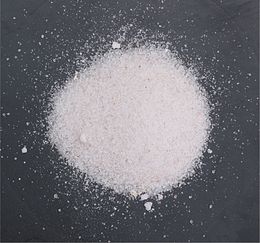Kieserite
| Kieserite | |
|---|---|
 | |
| General | |
| Category | Sulfate minerals |
| Formula (repeating unit) | MgSO4·H2O |
| IMA symbol | Ksr[1] |
| Strunz classification | 7.CB.05 |
| Dana classification | 29.6.2.1 |
| Crystal system | Monoclinic |
| Crystal class | Prismatic (2/m) (same H-M symbol) |
| Space group | C2/c |
| Unit cell | a = 7.51 Å, b = 7.61 Å c = 6.92 Å; β = 116.17°; Z = 4 |
| Identification | |
| Color | Colorless, grayish-white or yellowish |
| Crystal habit | Massive, granular; rarely as pyramidal crystals |
| Twinning | Contact on {001}, polysynthetic about [110] |
| Cleavage | {110} and {111} perfect |
| Fracture | Uneven |
| Tenacity | Fragile |
| Mohs scale hardness | 3.5 |
| Luster | Vitreous to dull |
| Streak | White |
| Diaphaneity | Transparent to translucent |
| Specific gravity | 2.57 |
| Optical properties | Biaxial (+) |
| Refractive index | nα = 1.520 nβ = 1.533 nγ = 1.584 |
| Birefringence | δ = 0.064 |
| 2V angle | 55° |
| Dispersion | r > v, moderate |
| Solubility | In water |
| References | [2][3][4] |
Kieserite is the magnesium sulfate mineral (MgSO4·H2O) and is named after Dietrich Georg von Kieser (Jena, Germany 1862). It has a vitreous luster and it is colorless, grayish-white or yellowish. Its hardness is 3.5 and crystallizes in the monoclinic crystal system. Gunningite is the zinc member of the kieserite group of minerals.[5]
Occurrence[]
Kieserite commonly occurs in marine evaporites and rarely in volcanic environments as a sublimate. It occurs in association with halite, carnallite, polyhalite, anhydrite, boracite, , leonite, epsomite and celestine.[4]
Mars[]
In early 2005, Mars Express, a European Space Agency orbiter, discovered evidence of kieserite in patches of Valles Marineris (the largest canyon on Mars), along with gypsum and polyhydrated sulfates. This is direct evidence of Mars's watery past and augments similar discoveries made by the Mars Exploration Rover Opportunity in 2004.
Uses[]
It is used in the production of Epsom salt and as a fertilizer, the overall global annual usage in agriculture in the mid 1970s was 2.3 million tons.[6]

Kieserite is also used for cleaning hard water deposits from tiles, stones, and other pool and fountain lining materials. Due to its hardness, which is greater than hard water deposits but less than tiles and other water feature linings, it is blasted at the hard water deposits to remove them.
See also[]
References[]
- ^ Warr, L.N. (2021). "IMA–CNMNC approved mineral symbols". Mineralogical Magazine. 85 (3): 291–320. Bibcode:2021MinM...85..291W. doi:10.1180/mgm.2021.43. S2CID 235729616.
- ^ "Kieserite data on Webmineral". Archived from the original on 2009-12-08. Retrieved 2009-04-26.
- ^ "Kieserite on Mindat.org". Archived from the original on 2009-03-19. Retrieved 2009-04-26.
- ^ a b "Kieserite in the Handbook of Mineralogy" (PDF). Archived (PDF) from the original on 2019-04-09. Retrieved 2020-06-08.
- ^ "Kieserite group on Mindat". Archived from the original on 2019-09-04. Retrieved 2020-06-08.
- ^ Industrial Inorganic Chemistry, Karl Heinz Büchel, Hans-Heinrich Moretto, Dietmar Werner, John Wiley & Sons, 2nd edition, 2000, ISBN 9783527613335
- Magnesium minerals
- Sulfate minerals
- Monoclinic minerals
- Minerals in space group 15
- Evaporite